HITLER CELEBRATES 56TH BIRTHDAY
Berlin, Germany · April 20, 1945
On this date in 1945, a stooped, jowly-faced Adolf Hitler celebrated his 56th birthday in his command bunker under Berlin’s Old Reich Chancellery. Unlike previous birthdays marked by much ceremony and fuss, this one was all gloom and doom due to the Wehrmacht’s failure to halt the Soviet advance on the Reich capital. Only the day before, Eva Braun, Hitler’s mistress and companion in his subterranean world, remarked hearing the sounds of artillery fire on the Eastern Front even in the bowels of the bunker. After midnight Hitler received a round of birthday congratulations from a dwindling circle of never-say-die Nazi big-wigs—Reich Marshal Hermann Goering, Propaganda Minister Joseph Goebbels, Foreign Minister Joachim von Ribbentrop, Reich Chancellery head and personal secretary Martin Bormann, Gestapo chief and Reichsfuehrer-SS Heinrich Himmler, Grand Adm. Karl Doenitz, Chief of the High Command of the Armed Forces (OKW) Wilhelm Keitel, Chief of the Operations Staff of the Armed Forces High Command Alfred Jodl, and technocrat and Armaments Minister Albert Speer. There was even a telegram from Benito Mussolini, a telegram sent just days before his capture and execution on April 28 by Italian partisans. As Hitler accepted birthday wishes with a limp handshake and vacant expression, the first Soviet units penetrated the southern edge of Berlin, now a moonscape of bomb craters and ruined buildings. Hitler seemed undecided about whether to flee his underground sanctuary for Berchtesgaden in the Bavarian Alps. Not his henchmen, who lost little time in scattering—Doenitz, Himmler, and Speer to the northwest, Goering to the south. In her Old Reich Chancellery apartment, Eva Braun threw a last little improvised party, where her boisterous guests (absent Hitler, who had withdrawn to his bedroom) drank champagne, laughed, and danced to an old hit record from 1929 as they tried to ignore the imminent end to Nazism. Two million mostly cave-dwelling Berliners, aware of the Soviets’ fast-closing dragnet, relished the extra rations of jam, sugar, coffee, and meat dispersed on April 22 as part of their leader’s birthday festivities, which presaged by eight days Hitler’s and Braun’s suicides. Their deaths were just two of nearly four thousand suicides reported in Berlin in April 1945.
[amazon_carousel widget_type=”ASINList” width=”600″ height=”200″ title=”Recommended Reading” market_place=”US” shuffle_products=”False” show_border=”False” asin=”1844159353,0099551896,0393322521,0142002801,1906033129,0307742601,0143122134,0060540370,0312614926,1848842309″ /]
Time Runs Out for Hitler and His Thousand-Year Reich
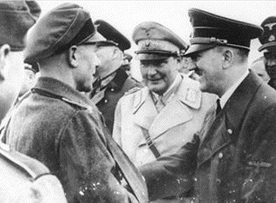 | 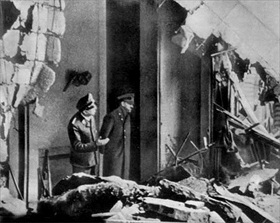 |
Left: Hitler visiting the Eastern Front in early April 1945. Behind him is Hermann Goering, Reichsmarschall and head of the now impotent Luftwaffe. Field Marshal Wilhelm Keitel, Chief of the High Command of the Armed Forces (OKW), is partially hidden behind Goering’s right shoulder. Keitel signed the German Instrument of Surrender in Soviet-occupied Berlin on May 9, 1945.
![]()
Right: Hitler and his adjutant peer into one of the rooms of the destroyed Reich Chancellery, Berlin, March 1945. The next month the Red Army, fighting street by street, captured the “lair of the fascist beast.” The Reich Chancellery and the Reichstag, symbols of Nazi power and prestige, became favorite sites of visiting Allied military and political leaders.
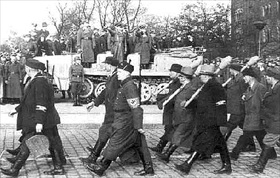 | 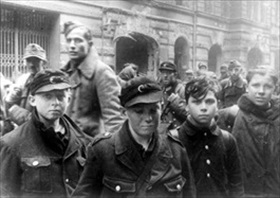 |
Left: Men of the Berlin Volkssturm (home army) march with Panzerfausts, single-shot, disposable bazookas. With graying hair and assorted coats and hats, black armbands with the words Deutscher Volkssturm Wehrmacht on their sleeves, these men scarcely looked like the kind of soldiers who would strike fear in 1.5 million battle-hardened Red Army soldiers. Yet over 100,000 Berliners tried.
![]()
Right: The end of the fight for four captured boy soldiers, probably Hitler Youth. Their compatriots in the Volkssturm were sometimes killed as “bandits” and “terrorists” when engaged by Soviet troops because they were not dressed in military attire.
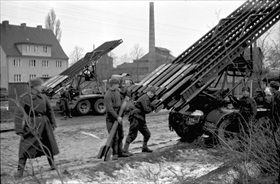 | 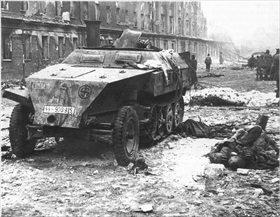 |
Left: A Soviet multiple rocket launcher fires its load into the center of Berlin, April 1945. It delivered a devastating amount of explosives in short order. Hitler relied on a semi-mythical force to lift the Soviet siege of his capital.
![]()
Right: Destroyed German Panzerwagen in a Berlin street. On May 2, 1945, Gen. Helmuth Weidling, commander of the Berlin garrison, used truck-mounted loudspeakers and word of mouth (no radio being available) to announce a ceasefire.
Last Newsreel from Goebbels’ Propaganda Ministry, March 22, 1945. Scenes Include Hitler Greeting 20 Hitler Youth on Grounds of the Semi-Destroyed Reich Chancellery
![]()
 History buffs, there is good news! The Daily Chronicles of World War II is now available as an ebook for $4.99 on Amazon.com. The ebook contains a year’s worth of dated entries from this website. Featuring inventive navigation aids, the ebook enables readers to instantly move forward or backward by month and date to different dated entries. Simple and elegant! Click here to purchase the ebook.
History buffs, there is good news! The Daily Chronicles of World War II is now available as an ebook for $4.99 on Amazon.com. The ebook contains a year’s worth of dated entries from this website. Featuring inventive navigation aids, the ebook enables readers to instantly move forward or backward by month and date to different dated entries. Simple and elegant! Click here to purchase the ebook.












